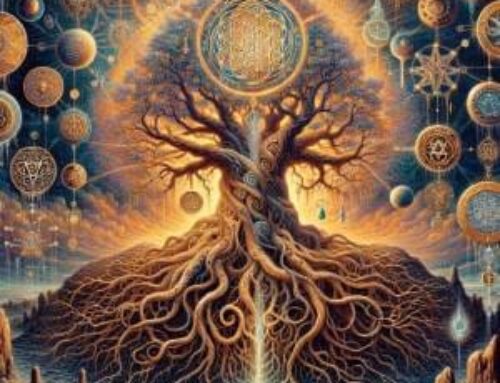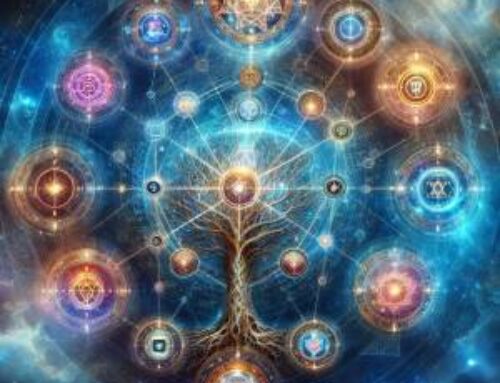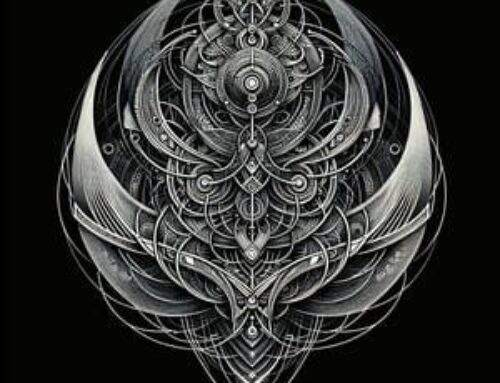Contents
- 1 Hermetic Alchemy: The Path to Enlightenment Through the Great Work and the Transmutation of Self
- 2 Introduction
- 3 The Origins of Hermetic Alchemy
- 4 Principles of Hermetic Alchemy
- 5 Symbols and Tools in Hermetic Alchemy
- 6 The Process of Alchemical Transmutation
- 7 Hermetic Alchemy and Modern Science
- 8 Hermetic Alchemy in Contemporary Spiritual Practice
- 9 Challenges and Misconceptions of Hermetic Alchemy
- 10 The Legacy and Future of Hermetic Alchemy
- 11 Exploring the Path Forward
- 12 Embrace the Initiatory Path of Alchemy
- 13 Explore the rich symbolism and teachings of Hermetic Alchemy.
- 14 10 Facts You Should Know About Alchemy (FAQ)
- 14.1 1. What is Hermetic Alchemy?
- 14.2 2. Who was Hermes Trismegistus?
- 14.3 3. What are the main principles of Hermetic Alchemy?
- 14.4 4. Can you explain the significance of Sulphur, Mercury, and Salt in Hermetic Alchemy?
- 14.5 5. What is the relationship between the seven metals and the seven chakras?
- 14.6 6. What is the Magnum Opus?
- 14.7 7. What is the relationship between Hermetic Alchemy and modern science?
- 14.8 8. Can Hermetic Alchemy be practiced today?
- 14.9 9. What are some common misconceptions about Hermetic Alchemy?
- 14.10 10. How can I learn more about Hermetic Alchemy?
Hermetic Alchemy: The Path to Enlightenment Through the Great Work and the Transmutation of Self
Introduction
In the quest to understand the mysteries of the universe and the inner workings of the soul, Hermetic Alchemy emerges as a beacon of ancient wisdom. This spiritual and philosophical discipline, rooted in the teachings of Hermes Trismegistus, transcends mere physical transmutation and offers a path to enlightenment and the harmonization of the material and spiritual realms. By exploring its origins, symbols, and transformative processes, we embark on a journey to uncover the profound depths of Hermetic Alchemy. This guide aims to illuminate the principles and practices of this arcane tradition, revealing its meaning and application in our quest for knowledge and self-transformation.

The Origins of Hermetic Alchemy
Hermetic Alchemy traces its roots to the figure of Hermes Trismegistus, a legendary sage said to have possessed immense knowledge and wisdom. The Hermetic tradition combines elements of Greek, Egyptian, and Christian thought, reflecting a syncretic fusion of spiritual practices and philosophies. The foundational texts of Hermeticism, notably “The Corpus Hermeticum” and “The Emerald Tablet,” contain cryptic passages that have guided alchemists for centuries in their quest for spiritual ascension and material perfection.
Principles of Hermetic Alchemy
At the heart of Hermetic Alchemy is the principle of “as above, so below,” a maxim that suggests that the macrocosm and microcosm are reflections of each other. This principle guides alchemists in their work, which seeks to reconcile the earthly and the divine through the transformation of matter and spirit. The ultimate goal is the achievement of the Magnum Opus or Great Work, which symbolizes the alchemist’s spiritual journey through the stages of blackening (nigredo), whitening (albedo), yellowing (citrinitas), and reddening (rubedo).
Symbols and Tools in Hermetic Alchemy
The history of Hermetic Alchemy is adorned with illustrious figures whose works have contributed significantly to its legacy. Among them, Paracelsus stands out as a Renaissance alchemist who introduced the concept of microcosm and macrocosm in medicine, echoing Hermetic principles. Nicholas Flamel is another legendary figure who is said to have achieved the transmutation of base metals into gold, symbolizing the spiritual awakening and transformation sought in Hermetic alchemy.
Central to the study of Hermetic Alchemy are key texts that have served as guides for practitioners throughout the ages. “The Emerald Tablet, attributed to Hermes Trismegistus himself, is renowned for its cryptic message that encapsulates the essence of alchemical transformation. “The Corpus Hermeticum, a collection of philosophical and theological texts, explores the nature of the divine, the cosmos, the mind, and the soul, offering profound insights into the interconnectedness of the universe.
The Process of Alchemical Transmutation
Alchemical transmutation is not simply the transformation of lead into gold, as it is commonly misunderstood, but the transformation of the alchemist’s soul. This process involves several stages, each with its own set of operations symbolizing spiritual purification and enlightenment. The journey begins with calcination, the burning of ego and attachment, followed by dissolution, where the remnants of the self are further broken down. Conjunction brings the purified elements together, leading to fermentation, the introduction of divine energy, culminating in coagulation, the realization of the true self or philosopher’s stone, representing enlightenment and eternal life.
Throughout the intricate tapestry of symbols, processes, and principles, one goal remains paramount in the practice of Hermetic Alchemy: the Magnum Opus, or Great Work. This pinnacle of alchemical achievement represents the creation of the Philosopher’s Stone, a symbol of ultimate wisdom and power that has fascinated alchemists for centuries. In more accessible terms, however, the Great Work is about transforming the lead of misunderstanding into the gold of enlightenment. It is a metaphor for the transformative journey of the soul, where the raw material of our unexamined beliefs and shadow selves is refined through understanding and spiritual practice into the enlightened essence of our true nature.
Hermetic Alchemy and Modern Science
The relationship between Hermetic Alchemy and modern science, particularly chemistry, is a testament to the enduring legacy of alchemical practices. While alchemy is often seen as a precursor to chemistry, its influence extends beyond mere scientific discovery. The principles of Hermetic Alchemy, such as transformation and unity, find echoes in quantum physics, where the interconnectedness of the universe is a fundamental concept. This intersection of ancient wisdom and modern science opens new avenues for understanding the nature of reality and our place within it.
Hermetic Alchemy in Contemporary Spiritual Practice
In the present day, the principles of Hermetic Alchemy continue to inspire spiritual seekers and practitioners in a variety of disciplines. Its symbols and teachings find expression in modern occultism, mysticism, and New Age practices, offering tools for personal transformation and exploration of the inner self. Through meditation, ritual, and the study of alchemical texts, individuals seek to achieve inner balance and unity, embodying the Hermetic maxim, “As above, so below,” in their quest for spiritual enlightenment.
Challenges and Misconceptions of Hermetic Alchemy
Despite its rich heritage, Hermetic Alchemy is often shrouded in mystery and misunderstanding. The esoteric nature of its teachings, combined with historical misinterpretations, has led to a view of alchemy as mere fantasy or pseudoscience. Addressing these misconceptions requires a deeper understanding of alchemy’s symbolic language and allegorical expressions, and recognizing its value as a spiritual and philosophical tradition rather than a literal guide to material transmutation.
The Legacy and Future of Hermetic Alchemy
The legacy of Hermetic Alchemy is a testament to the enduring quest for knowledge and understanding of the cosmos and the self. As a spiritual and philosophical tradition, it offers profound insights into the nature of reality, the process of transformation, and the quest for enlightenment. In today’s world, its principles continue to resonate, offering guidance and inspiration to those on the path of spiritual development. As we look to the future, Hermetic Alchemy remains a beacon of wisdom, inviting us to explore the mysteries of the universe and our place within it.
Exploring the Path Forward
As we navigate the complexities of our modern world, the timeless wisdom of Hermetic Alchemy offers a beacon of light for those seeking deeper understanding and spiritual growth. The principles and practices of this ancient tradition remind us of the transformative power of knowledge and the potential for personal alchemy in our lives. For those drawn to the mysteries of Hermetic Alchemy and the quest for spiritual enlightenment, the journey is both profound and rewarding.The Hermetic Academy stands as a guardian of this sacred wisdom, offering seekers an authentic path into the heart of Hermetic Alchemy.
As the guardian of the initiatory tradition, the Academy offers comprehensive teachings that bridge the ancient and the modern, the spiritual and the practical. Through its courses, workshops, and community, the Hermetic Academy invites you to embark on a transformative journey guided by the principles of Hermeticism and the pursuit of spiritual alchemy.
Embrace the Initiatory Path of Alchemy
Joining the Hermetic Academy offers more than an education-it is an initiation into a living tradition that has the power to change the way you see the world and yourself. Whether you are new to the path or seeking to deepen your existing practice, the Academy provides a structured, supportive environment in which to do so:
Explore the rich symbolism and teachings of Hermetic Alchemy.
Engage with a community of like-minded individuals passionate about spiritual growth.
Receive guidance from experienced practitioners dedicated to the authentic transmission of Hermetic wisdom.
By stepping into this ancient stream of knowledge, you open the door to personal transformation and the realization of your highest potential. The Hermetic Academy is your gateway to an enduring spiritual heritage, offering the keys to understanding and applying the timeless principles of Hermetic Alchemy in your life. Discover the teachings, practices and community that await you at the Hermetic Academy. Embrace the journey of transformation and become part of a lineage of seekers who have walked this initiatory path before you.
10 Facts You Should Know About Alchemy (FAQ)
1. What is Hermetic Alchemy?
Hermetic Alchemy is a spiritual and philosophical tradition that focuses on the transformation of the self and the understanding of the universe. It is rooted in the teachings of Hermes Trismegistus and combines elements of Greek, Egyptian, and Christian thought.
2. Who was Hermes Trismegistus?
Hermes Trismegistus is a legendary sage who is considered the author of the Hermetic Corpus, a series of sacred texts that form the basis of Hermetic philosophy and alchemy. He is often regarded as a synthesizer of mysticism and a bridge between ancient Egyptian and Greek knowledge.
3. What are the main principles of Hermetic Alchemy?
The main principles include “as above, so below,” which emphasizes the correspondence between the macrocosm and the microcosm, and the process of transformation leading to the Magnum Opus or Great Work, which symbolizes the ultimate spiritual awakening and enlightenment.
4. Can you explain the significance of Sulphur, Mercury, and Salt in Hermetic Alchemy?
In Hermetic Alchemy, Sulphur, Mercury and Salt represent spiritual concepts rather than physical substances. Sulphur corresponds to self-consciousness, Mercury to superconsciousness, and Salt to subconsciousness, each of which plays a critical role in the alchemical transformation process.
5. What is the relationship between the seven metals and the seven chakras?
The alchemical transformation of the seven metals parallels the journey through the seven chakras, with each metal and chakra representing a phase of inner awakening and spiritual development. This analogy emphasizes the interconnectedness of physical and spiritual processes.
6. What is the Magnum Opus?
The Magnum Opus, or Great Work, is the goal of Hermetic Alchemy, involving the creation of the Philosopher’s Stone and the attainment of spiritual enlightenment. It symbolizes the transformation from the lead of ignorance to the gold of wisdom.
7. What is the relationship between Hermetic Alchemy and modern science?
Hermetic Alchemy and modern science, especially chemistry and quantum physics, share a focus on transformation and the fundamental interconnectedness of the universe. The influence of alchemy is seen as a precursor to scientific inquiry and understanding.
8. Can Hermetic Alchemy be practiced today?
Yes, Hermetic Alchemy can be practiced as a spiritual and philosophical path. Modern practitioners engage with its symbols, teachings, and processes through meditation, ritual, and study, applying ancient wisdom to contemporary spiritual growth.
9. What are some common misconceptions about Hermetic Alchemy?
Common misconceptions include seeing it as merely an attempt to turn lead into gold, or as an outdated pseudoscience. In reality, it is a rich spiritual and philosophical tradition focused on inner transformation and enlightenment.
10. How can I learn more about Hermetic Alchemy?
To learn more, consider studying the foundational texts of Hermeticism, such as “The Corpus Hermeticum” and “The Emerald Tablet,” and getting involved with communities or institutions, such as the Hermetic Academy, that offer structured, authentic teachings, initiations, and support for those on the path.





